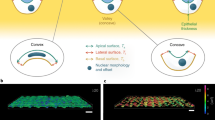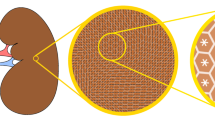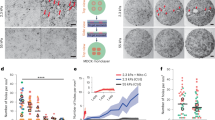Abstract
Signalling between mesenchymal and epithelial cells has a profound influence on organ morphogenesis. However, less is known about the mechanical function of epithelial–mesenchymal interactions. Here, we describe two principal effects by which epithelia can regulate shape changes in mesenchymal cell aggregates. We propose that during formation of the embryonic body axis, the epithelial layer relieves surface minimizing tensions that would force cell aggregates into a spherical shape, and controls the serial arrangement of cell populations along the axis. The combined effects permit the tissue to deviate from a spherical form and to elongate.
This is a preview of subscription content, access via your institution
Access options
Subscribe to this journal
Receive 12 print issues and online access
$209.00 per year
only $17.42 per issue
Buy this article
- Purchase on Springer Link
- Instant access to full article PDF
Prices may be subject to local taxes which are calculated during checkout





Similar content being viewed by others
References
Schock, F. & Perrimon, N. Molecular mechanisms of epithelial morphogenesis. Ann. Rev. Cell Dev. Biol. 18, 463–493 (2002).
Steinberg, M. S. in Specificity of Embryological Interactions (ed. Garrod, D. R.) 99–131 (Chapman & Hall, London, 1978).
Beysen, D. A., Forgacs, G. & Glazier, J. A. Cell sorting is analogous to phase ordering in fluids. Proc. Natl Acad. Sci. USA 97, 9467–9471 (2000).
Keller, R. Shaping the vertebrate body plan by polarized embryonic cell movements. Science 298, 1950–1954 (2002).
Smith, J. C., Price, B. M., Green, J. B., Weigel, D. & Herrmann, B. G. Expression of a Xenopus homolog of Brachyury (T) is an immediate-early response to mesoderm induction. Cell 67, 79–87 (1991).
Keller, R. & Danilchik, M. Regional expression, pattern and timing of convergence and extension during gastrulation of Xenopus laevis . Development 103, 193–209 (1988).
Shih, J. & Keller, R. Cell motility driving mediolateral intercalation in explants of Xenopus laevis . Development 116, 901–914 (1992).
Davis, G. S., Phillips, H. M. & Steinberg, M. S. Germ-layer surface tensions and “tissue affinities” in Rana pipiens gastrulae: Quantitative measurements. Dev. Biol. 192, 630–644 (1997).
del Rio, O. I. & Neumann, A. W. Axisymmetric drop shape analysis: computational methods for the measurement of interfacial properties from the shape and dimensions of pendant and sessile drops. J. Colloid Interface Sci. 196, 136–147 (1997).
Chalmers A. D. et al. aPKC, Crumbs3 and Lgl2 control apicobasal polarity in early vertebrate development. Development 132, 977–986 (2005).
Kim, S. H., Yamamoto, A., Bouwmeester, T., Agius, E. & De Robertis, E. M. The role of paraxial protocadherin in selective adhesion and cell movements of the mesoderm during Xenopus gastrulation. Development 125, 4681–4690 (1998).
Chen, X. J. & Gumbiner, B. M. Paraxial protocadherin mediates cell sorting and tissue morphogenesis by regulating C-cadherin adhesion activity. J. Cell Biol. 174, 301–313 (2006).
Sasai, Y., Lu, B., Piccolo, S. & De Robertis, E. M. Endoderm induction by the organizer-secreted factors chordin and noggin in Xenopus animal caps. EMBO J. 15, 4547–4555 (1996).
Sasai, Y. et al. Xenopus chordin: a novel dorsalizing factor activated by organizer-specific homeobox genes. Cell 79, 779–790 (1994).
Townes, P. L. & Holtfreter, J. Directed movements and selective adhesion of embryonic amphibian cells. J. Exp. Zool. 128, 53–120 (1955).
Steinberg, M. S. Reconstruction of tissues by dissociated cells. Some morphogenetic tissue movements and the sorting out of embryonic cells may have a common explanation. Science 141, 401–408 (1963).
Green, J. B., New, H. B. & Smith J. C. Responses of embryonic Xenopus cells to activin and FGF are separated by multiple dose thresholds and correspond to distinct axes of the mesoderm. Cell 71, 731–739 (1992).
Ninomiya, H., Elinson, R. P. & Winklbauer, R. Antero-posterior tissue polarity links mesoderm convergent extension to axial patterning. Nature 430, 364–367 (2004).
Gurdon, J. B. & Bourillot, P. Y. Morphogen gradient interpretation. Nature 413, 797–803 (2001).
Schier, A. F. Nodal signaling in vertebrate development. Annu. Rev. Cell Dev. Biol. 19, 589–621 (2003).
Schnabel, R. et al. Global cell sorting in the C. elegans embryo defines a new mechanism for pattern formation. Dev. Biol. 294, 418–431 (2006).
Steinberg, M. S. Does differential adhesion govern self-assembly processes in histogenesis? Equilibrium configurations and the emergence of a hierarchy among populations of embryonic cells. J. Exp. Zool. 173, 395–434 (1970).
Steinberg, M. S. & Takeichi, M. Experimental specification of cell sorting, tissue spreading, and specific spatial patterning by quantitative differences in cadherin expression. Proc. Natl Acad. Sci. USA 91, 206–209 (1994).
Foty, R. A., Pfleger, C. M., Forgacs, G. & Steinberg, M. S. Surface tensions of embryonic tissues predict their mutual envelopment behavior. Development 122, 1611–1620 (1996).
Nardi, J. B. & Stocum D. L. Surface properties of regenerating limb cells: evidence for gradation along the proximodistal axis. Differentiation 25, 27–31 (1983).
Koibuchi, N. & Tochinai, S. Existence of gradient in cell adhesiveness along the developing Xenopus hind limb bud, shown by a cellular sorting-out experiment in vitro . Dev. Growth Differ. 40, 355–362 (1998).
Kuroda, H., Sakumoto, H., Kinoshita, K. & Asashima, M. Changes in the adhesive properties of dissociated and reaggregated Xenopus laevis embryo cells. Dev. Growth Differ. 41, 283–291 (1999).
Tepass, U., Godt, D. & Winklbauer, R. Cell sorting in animal development: signalling and adhesive mechanisms in the formation of tissue boundaries. Curr. Opin. Genet. Dev. 12, 572–582 (2002).
Harland, R. M. In situ hybridization: an improved whole-mount method for Xenopus embryos. Methods Cell Biol. 36, 685–695 (1991).
Angres, B., Muller, A. H., Kellermann, J. & Hausen, P. Differential expression of two cadherins in Xenopus laevis . Development 111, 829–844 (1991).
Acknowledgements
We thank: P. Hausen for 6D5 antibodies; E. M. DeRobertis, N. Papalopulu, Y. Sasai and J. Smith for plasmids; A. W. Neumann and A. Kalantarian for ADSA simulations; and T. Harris, P. Zandstra, E. Aacosta, U. Tepass, D. Godt and V. Tropepe for critical reading of the manuscript. Work was supported by grants from the Canadian Institutes of Health Research (MOP-53075) and the Canada Foundation for Innovation to R.W. and by a postdoctoral fellowship from the Japan Society for the Promotion of Science to H.N.
Author information
Authors and Affiliations
Contributions
H.N. planned the project and carried out the experiments. H.N. and R.W. analysed the data and wrote the paper.
Corresponding author
Supplementary information
Supplementary Information
Supplementary figures S1, S2, S3, S4, Movie legends, Supplementary Table S1 and Supplementary Discussion (PDF 783 kb)
Supplementary Information
Supplementary Movie 1 (MOV 1290 kb)
Supplementary Information
Supplementary Movie 2 (MOV 1998 kb)
Rights and permissions
About this article
Cite this article
Ninomiya, H., Winklbauer, R. Epithelial coating controls mesenchymal shape change through tissue-positioning effects and reduction of surface-minimizing tension. Nat Cell Biol 10, 61–69 (2008). https://doi.org/10.1038/ncb1669
Received:
Accepted:
Published:
Issue Date:
DOI: https://doi.org/10.1038/ncb1669
This article is cited by
-
Mechanical forces direct stem cell behaviour in development and regeneration
Nature Reviews Molecular Cell Biology (2017)
-
Quantitative approaches in developmental biology
Nature Reviews Genetics (2009)
-
Control of tumourigenesis by the Scribble/Dlg/Lgl polarity module
Oncogene (2008)
-
Sophistications of cell sorting
Nature Cell Biology (2008)



